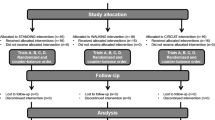Abstract
Postprandial physical activity may blunt the blood glucose response. In diabetes prone female immigrants only slow walking is regularly performed raising the question of whether also this type of physical activity can attenuate their post meal blood glucose elevation. Using a cross over design, 11 female Pakistani immigrants living in Oslo were recruited to participate in three experiments where their blood glucose concentration was measured every 15 min for 2 h after intake of a high glycemic food, either while resting after the meal or doing very light post meal walking of two durations. Postprandial blood glucose peak value and incremental area under the 2 h blood glucose curve decreased with increasing duration of slow post meal walking. Also the blood pressure was lowered. Post meal walking can strongly attenuate the glycemic response to carbohydrates and reduce blood pressure in a high risk group of immigrants.




Similar content being viewed by others
References
Kumar BN, Meyer HE, Wandel M, Dalen I, Holmboe-Ottesen G. Ethnic differences in obesity among immigrants from developing countries, in Oslo, Norway. Int J Obes (Lond). 2006;30(4):684–90.
Jenum AK, Holme I, Graff-Iversen S, Birkeland KI. Ethnicity and sex are strong determinants of diabetes in an urban Western society: implications for prevention. Diabetologia. 2005;48(3):435–9.
Washington DUDoHaHS. Physical activity guidelines advisory committee report. 2008.
Zilversmit DB. Atherogenesis: a postprandial phenomenon. Circulation. 1979;60(3):473–85.
Ceriello A, Davidson J, Hanefeld M, Leiter L, Monnier L, Owens D, et al. Postprandial hyperglycaemia and cardiovascular complications of diabetes: an update. Nutr Metab Cardiovasc Dis. 2006;16(7):453–6.
Aryangat AV, Gerich JE. Type 2 diabetes: postprandial hyperglycemia and increased cardiovascular risk. Vasc Health Risk Manag. 2010;6:145–55.
Borg’s perceived exertion and pain scales. Champaign: Human Kinetics; 1998.
Helsedirektoratet. Aktivitetshåndboken. 2009.
Hjellset VT, Bjørge B, Eriksen HR, Høstmark AT. Risk factors for type 2 diabetes among female Pakistani immigrants: the InvaDiab-DEPLAN study on Pakistani immigrant women living in Oslo, Norway. J Immigr Minor Health. 2011;13:101–110.
Høstmark AT, Ekeland GS, Beckstrom AC, Meen HD. Postprandial light physical activity blunts the blood glucose increase. Prev Med. 2006;42(5):369–71.
Aadland E, Høstmark AT. Very light physical activity after a meal blunts the rise in blood glucose and insulin. Open Nutr J. 2008;2:94–9.
Nygaard H, Tomten SE, Høstmark AT. Slow postmeal walking reduces postprandial glycemia in middle-aged women. Appl Physiol Nutr Metab. 2009;34(6):1087–92.
Cardoso CG Jr, Gomides RS, Queiroz AC, Pinto LG, da Silveira LF, Tinucci T, et al. Acute and chronic effects of aerobic and resistance exercise on ambulatory blood pressure. Clinics (Sao Paulo). 2010;65(3):317–25.
Johansen KS, Bjorge B, Hjellset VT, Holmboe-Ottesen G, Raberg M, Wandel M. Changes in food habits and motivation for healthy eating among Pakistani women living in Norway: results from the InnvaDiab-DEPLAN study. Public Health Nutr. 2010;13(6):858–67.
Parkes JL, Slatin SL, Pardo S, Ginsberg BH. A new consensus error grid to evaluate the clinical significance of inaccuracies in the measurement of blood glucose. Diabetes Care. 2000;23(8):1143–8.
Steele MK, Schrock LE, Baum JM. Performance of a new ascensia contour blood glucose monitoring system. Diabetes. 2007;56:A527.
Borg G. Perceived exertion as an indicator of somatic stress. Scand J Rehabil Med. 1970;2(2):92–8.
Carbohydrates in human nutrition. Report of an FAO/WHO expert consultation on carbohydrates, 14–18 April 1997. Report No.: 66. Rome, Italy: FAO/WHO; 1998.
Wolever TM. Effect of blood sampling schedule and method of calculating the area under the curve on validity and precision of glycaemic index values. Br J Nutr. 2004;91(2):295–301.
Dickinson S, Colagiuri S, Faramus E, Petocz P, Brand-Miller JC. Postprandial hyperglycemia and insulin sensitivity differ among lean young adults of different ethnicities. J Nutr. 2002;132(9):2574–9.
Zahid N. Doctoral thesis. Prevalence of diabetes in Kharian, Pakistan. 2008.
Kandula NR, Diez-Roux AV, Chan C, Daviglus ML, Jackson SA, Ni H, et al. Association of acculturation levels and prevalence of diabetes in the multi-ethnic study of atherosclerosis (MESA). Diabetes Care. 2008;31(8):1621–8.
Wandel M, Raberg M, Kumar B, Holmboe-Ottesen G. Changes in food habits after migration among South Asians settled in Oslo: the effect of demographic, socio-economic and integration factors. Appetite. 2008;50(2–3):376–85.
Hu FB, Sigal RJ, Rich-Edwards JW, Colditz GA, Solomon CG, Willett WC, et al. Walking compared with vigorous physical activity and risk of type 2 diabetes in women: a prospective study. JAMA. 1999;282(15):1433–9.
Bonuccelli S, Muscelli E, Gastaldelli A, Barsotti E, Astiarraga BD, Holst JJ, et al. Improved tolerance to sequential glucose loading (Staub-Traugott effect): size and mechanisms. Am J Physiol Endocrinol Metab. 2009;297(2):E532–7.
Douen AG, Ramlal T, Rastogi S, Bilan PJ, Cartee GD, Vranic M, et al. Exercise induces recruitment of the “insulin-responsive glucose transporter”. Evidence for distinct intracellular insulin- and exercise-recruitable transporter pools in skeletal muscle. J Biol Chem. 1990;265(23):13427–30.
Steptoe A, Dockray S, Wardle J. Positive affect and psychobiological processes relevant to health. J Pers. 2009;77(6):1747–76.
Brotman DJ, Golden SH, Wittstein IS. The cardiovascular toll of stress. Lancet. 2007;370(9592):1089–100.
Høstmark AT. Variations in the glycemic response to carbohydrates: do high responders have a special benefit of using low glycemic foods? Open Nutr J. 2007;1:1–4.
Altman DG. Practical statistics for medicinal research. London/Boca Raton: Chapman & Hall/CRC; 1991.
Lima LC, Assis GV, Hiyane W, Almeida WS, Arsa G, Baldissera V, et al. Hypotensive effects of exercise performed around anaerobic threshold in type 2 diabetic patients. Diabetes Res Clin Pract. 2008;81(2):216–22.
Mach C, Foster C, Brice G, Mikat RP, Porcari JP. Effect of exercise duration on postexercise hypotension. J Cardiopulm Rehabil. 2005;25(6):366–9.
Wolever TM, Vorster HH, Bjorck I, Brand-Miller J, Brighenti F, Mann JI, et al. Determination of the glycaemic index of foods: interlaboratory study. Eur J Clin Nutr. 2003;57(3):475–82.
Acknowledgments
The technical assistance of Eva Kristensen and Monica Morris is gratefully acknowledged.
Author information
Authors and Affiliations
Corresponding author
Rights and permissions
About this article
Cite this article
Lunde, M.S.H., Hjellset, V.T. & Høstmark, A.T. Slow Post Meal Walking Reduces the Blood Glucose Response: An Exploratory Study in Female Pakistani Immigrants. J Immigrant Minority Health 14, 816–822 (2012). https://doi.org/10.1007/s10903-012-9574-x
Published:
Issue Date:
DOI: https://doi.org/10.1007/s10903-012-9574-x




